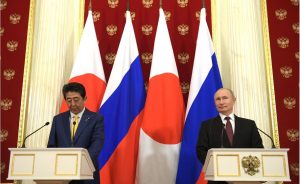By Gabriel Gavin

Last month, thousands of troops, tanks, and rocket launchers paraded through Moscow’s Red Square, marking 76 years since the end of World War II, which claimed the lives of around 24 million people across the former USSR. But, more than 7,000 kilometers to the east of the Russian capital, the Kuril Islands continue to hamper efforts to draw a line under the bloodshed and finally sign a peace treaty with Japan. Until the status of the volcanic archipelago is settled, Imperial Japan and the Soviet Union remain, technically at least, in a state of war.
Soviet troops landed on the territory in August 1945, just five days before Tokyo’s representatives signed their declaration of surrender aboard the USS Missouri. The Yalta Agreement, penned by the Allies months before the Red Army set off, had promised the archipelago to Moscow, in exchange for entering the war in the Pacific against the Axis power.
Since then, though, Japan has sought to overturn the terms of the deal, insisting that the four southernmost islands, which it refers to as its “Northern Territories,” were not actually covered by WWII-era treaties. Tokyo claims that they had not previously been considered a part of the Kurils, as described in the document, and should therefore be handed back to Japanese control.
That deadlock has for years been the thorn in the side of relations between Japan and Russia. For right-wing activists and commentators in Japan, the status of the islands is a question of national pride, and a sign that it has not fully recovered all that it lost in the wake of the war. However, that view is not universal, and only 44 percent of Japanese citizens polled in 2019 said they were in favor of any number of the islands being returned, with only one in three backing bringing all four back under their country’s control.
In Moscow, by contrast, the debate comes down to national security, given the islands lie in the strategic East Pacific, where its navy is increasingly engaged in standoffs with warships belonging to the United States and its allies. In addition, the Kuril Islands’ past role as the launch pad for a brief Japanese invasion of Russian land is undeniably a factor. A difficult diplomatic situation has since been further cemented by President Vladimir Putin’s constitutional reforms, passed after last year’s nationwide vote, which binds Moscow to preserve its territorial boundaries for eternity, ruling out the question of ever trading away part of the country.
Last week, however, Russian President Vladimir Putin made headlines by declaring that the constitutional reforms do not pose an obstacle to peace talks. “We are ready to continue negotiations,” he said during a virtual press conference. His comments sparked another round of the “will-they-or-won’t-they” type speculation that had surrounded peace efforts under Putin and former Prime Minister Abe Shinzo.
Further complicating matter, the impasse has now taken on another dimension as a proxy issue that flares up and quiets down according to relations between East and West. Washington, which originally supported Soviet forces landing on the islands, has since done something of an about-turn on their status. At the end of last year, the Hokkaido Shimbun newspaper uncovered that the U.S. State Department considers anyone born on Habomai, Shikotan, Kunashir, or Iturup, which Tokyo claims as its sovereign territory, to be a Japanese citizen.
That decision flies in the face of the fact that the Japanese civilian population was almost entirely expelled along with its army garrison at the end of WWII. Indeed, many of the islands’ residents belong to the ethnic Ainu population and/or are descended from Russian, Ukrainian, and Tatar workers shipped there during the communist era. However, given the fraught state of ties at present, the dispute is another convenient lever with which to apply pressure.
No comments:
Post a Comment